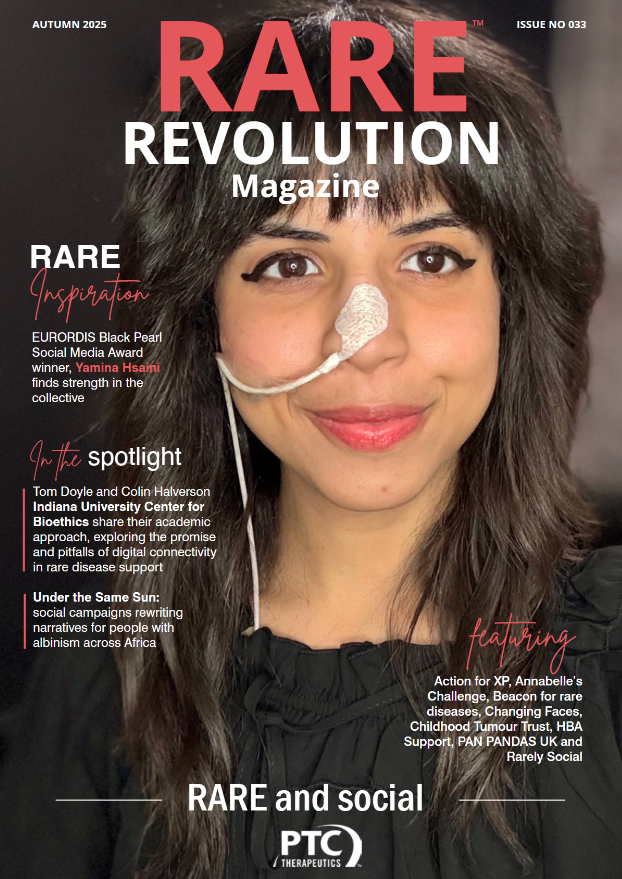Daniel Lewi of The CATS Foundation

When Daniel Lewi’s daughter was diagnosed with Tay-Sachs, he discovered there was no dedicated UK charity offering support to families such as his, and so along with his wife, set up The CATS Foundation. He talks to RARE Revolution about the incredible support network his organisation has created, and about their involvement in the first clinical trial; ever hopeful of finding a cure
CEO Series: meeting the beating hearts behind the RARE brands
1.
What made you want to move into the wide world of rare disease, and then specifically The CATS Foundation and what did that journey look like?
My eldest daughter Amélie was diagnosed with a rare disease called Tay-Sachs in 2011 when she was 15 months of age. At the time there was no dedicated charity in the UK or Europe providing information or support about the disease. My wife Patrícia and I started speaking with other families and although we were told at Amélie’s diagnosis that we probably wouldn’t meet another family impacted by the disease, we started to realise that this wasn’t actually the case. Research at the time was still in its infancy, but for us the main thing was that we, as a community, needed support for each other, from each other. So, we put things in place and set-up the Cure & Action for Tay-Sachs (CATS) Foundation to provide support to families affected by Tay-Sachs and Sandhoff disease (known as GM2 gangliosidosis together) in July 2011.
The journey at the beginning was very daunting, but we were lucky that we had a motivated community who wanted support and wanted to help each other. We’ve also been fortunate to be members of groups like the UK LSD Collaborative who have been instrumental in sharing best practices, advice and guidance as we have navigated the realities and challenges of running a viable charity for a rare disease. This is not only focussed on what support we can give, but help on funding and making us sustainable–this is the most important part as families will always need support. Other groups, like Findacure have really helped us with the fantastic workshops they run and the rare disease community in general is very collaborative, we are always helping each other when we can.

2.
What do you anticipate will be the biggest challenges and opportunities for your organisation in the next two years?
Our biggest challenge is always going to be funding, although I think this is a concern for all small charities. We need to ensure that we are sustainable and that we can continue to do the great work of supporting people. Opportunity wise, we are fortunate that we now have an active research community who are investigating various different treatment options. This in itself will bring challenges because we have to manage expectations of our families about what these treatments can do. But, it’s an exciting place to be and when we look back at how far we have come in nine years it’s a testament to hard work and a close-knit community!
3.
What is your proudest moment in your career thus far?
The proudest moment is seeing families smiling at our family conferences. It’s the old cliché, but we do all become one big family and the genuine feelings of warmth that we have for each other always brings a tear to my eye. We have families who have lost children to the disease, have a newly diagnosed family member or they themselves suffer from Tay-Sachs and Sandhoff who attend our family conferences and it’s amazing to see everyone relax and just be themselves.
Another proud moment was the recruitment of the first trial. We have been involved in this from the very beginning and it’s remarkable to see a treatment started that we, as a community, had so much involvement in.
4.
What and who are your personal and professional inspirations and why?
Amélie and my other children Grace and Seth are a big inspiration to me. How she coped with suffering from Tay-Sachs for eight years was inspiring. She showed such determination and strength each day and was an amazing role model to her siblings. When she died, she died on her own terms peacefully at home with her mum holding her hand. It’s the worst thing to happen to you as a parent to lose a child, but we really believe she left us on her own terms.
Grace and Seth are massive drivers for us. They were always aware that Amélie was different and needed more help from us and it is truly remarkable how much empathy they both have at such a young age. Grace, who is now the age that Amélie was when she passed away, is such a force and she is constantly getting involved in the projects that we do at The CATS Foundation–it makes us so proud.
My other inspirations are the families and children we have met over almost 10 years. They are all so strong and continue to be so and we’ve made friends for life within our community.
5.
What advice would you give someone considering working in the rare disease space?
It is an all-consuming environment! It’s not just a job, it’s actually enforcing change and helping people who are, in some cases, going through the worst moments in their life. You can 100% make a difference, but you have to be willing to commit. The rewards are amazing though–the first trial we got started is one of those moments I will never forget and to know you are part of something like that really is a key driver.
6.
Do you think the government does enough for the rare disease community at a local and central level, and what gaps do you see currently or emerging?
You can never do enough for the rare disease community. Sadly, it’s up to the charities and our communities to be constantly banging the drum to get our voices heard on a local, regional and national level. My major concern is that this trend of people having to fight for a treatment option will continue and I hope that the government will step up, take responsibility and stop putting the price of someone’s life against the cost of a treatment. I find that morally wrong and it must stop.
7.
What would you say are some of the biggest motivators for your employees?
Everyone at The CATS Foundation has a personal connection to Tay-Sachs or Sandhoff disease. We have all lost a child to these awful diseases and are fully committed to doing anything to help families after a diagnosis and to drive forward the research for treatments.
8.
What are the toughest parts of being a CEO, and conversely what are the most rewarding?
As a charity CEO the toughest part of the role is handling the responsibility of an entire community. I’m fully aware that we are fighting for our children all the time and every time we lose a child it breaks my heart as it means we still don’t have that all elusive cure. It’s something that will never get easier. But each year we are getting closer and the work by doctors, researchers and pharma will, I’m confident, get us there in the near future.
For me, the most rewarding part is seeing families supporting each other. As a charity we were born out of the fact that there was no other environment where families could turn to each other and discuss the reality of the disease. By that, I mean the harsh reality. The topics like how you handle taking a doubly incontinent eight year old child out for the day, how do you manage having carers in your house, how do you juggle work, how do you function on sleep deprivation. We now have this community and I find that the biggest success. Our research has moved forward, treatments are close, but families no longer feel lonely. That to me, is a success.
9.
What would be your one wish for The CATS Foundation for the year ahead?
In the next year I’d really like us to expand our support offering so that it has a real nationwide reach. The current pandemic has restricted our ability to hold face-to-face conferences and catch ups, but I really hope that this time next year we will have had a family conference for 2021!
10.
If you weren’t CEO of The CATS Foundation, what was Plan B? What did your 10-year-old self want to do as a job?
Before I was drawn into the rare disease world my life was very different! Like many people who set-up rare disease charities we never had an intention to enter this world, but now we are here to stay and make a difference.
However, as a child, I wanted to be an archaeologist. Or, as my mum tells me I used to say, a dinosaur digger-upper!
To find out more about the work of The CATS Foundation, please visit;
www.cats-foundation.org




